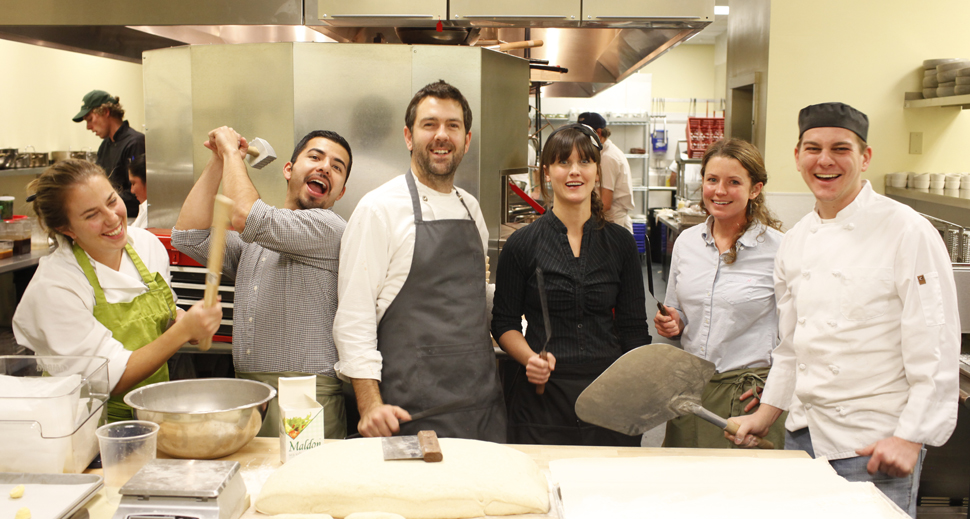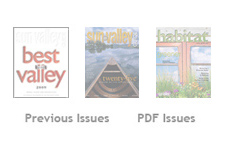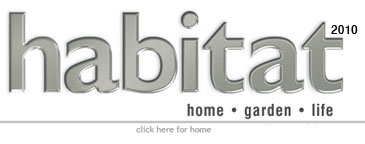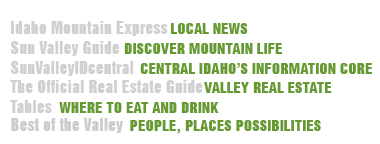| do habitat
Run a Green Business
Restaurants lead the way in sustainable business models
By Sabina Dana Plasse. Photo by David N. Seelig
Adorning a business with eco-conscious “green credentials” is not as daunting a task as it may seem. Follow the lead of forward-thinking valley restaurants that endorse sustainable business models by contributing to both a sustainable economy and the well-being of the planet. From the ingredients they use to basic operations, valley restaurants are serious about implementing green living and sustainability practices on a daily basis.
By its nature, a restaurant has many options for going green, but employing green business practices, including using sustainable building materials for constructing or remodeling, applies to all industries.
At Ketchum’s newest restaurant, Sego, being green was part of the business plan (and menu) from its inception. Owner Kevin Steussi went out of his way to build his contemporary restaurant almost exclusively employing local artisans and contractors.
Ketchum potter Lauren Street created 180 bowls for Sego at Boulder Mountain Clayworks, and Sten Sorenson of Ketchum’s Glassworks made Sego’s hostess stand with wood recovered from a railroad trestle in Utah. Rob Beck supplied applewood cuttings sourced from Idaho apple orchards for the kitchen’s wood-fired oven, and the restaurant’s tables and banquettes were made in Burley from recycled wood. Employing local businesses, even those that aren’t outwardly green, is an essential element in working toward a sustainable community.
Taking sustainable practices further, Sego is working with the Environmental Resource Center, food co-op Idaho’s Bounty and Blaine County School Superintendent Lonnie Barber to build a community garden across the street from the restaurant. The garden is intended to inspire children to cook fresh food and provide a resource for the community. “It will build a culinary tradition from the earth,” said Sego Executive Chef Taite Pearson. “Food is not just on a plate to eat, it’s an experience.”
Back to basics—back to the food. Idaho’s economy has long been tied to its agriculture, and by supporting locally grown produce, a business hits two essential pillars of the environmental movement. Buying local reduces the environmental impacts of lengthy transport and contributes to the sustainability of a local economy. In addition, customers like it. “It’s important for people to know where food comes from and not be scared of it,” said Pearson. “We know all the owners of every farm and ranch we buy from.”
The restaurant’s list of Idaho purveyors includes several Buhl farmers and ranchers, including MM Heath Farms, which provides such delicacies as sugar pumpkin, butternut, delicata and red kuri squashes and, of course, potatoes. Sego also serves Idaho cheeses from Rollingstone Chèvre (Snake River Valley) and Ballard Family Farms (Gooding). The pig’s feet and chicken eggs are from Dick and Melinda Spring’s Blaine County farm.
Pearson has a special affection for pork and serves a trio of pork with heirloom beans, which includes pork jowls and bellies from Gem Farms near Boise. “It speaks simplicity and getting back to the roots of rustic American food,” Pearson said.
While it’s the new kid on the block, Sego is not the first restaurant to embrace the sustainability and scrumptiousness of local food. Scott Mason, executive chef and owner of the Ketchum Grill, has bought lamb from Lava Lake Lamb in Carey since the ranch opened in 1999. But the latest sustainable practice Mason has implemented is buying a whole, hormone- and antibiotic-free cow from Chickadee Creek Ranch outside of Twin Falls. “The cows are grass fed,” Mason said. “It was a big commitment money-wise, but it works. And it’s exciting for the cooks to work with a whole cow.”
An innovative green businessman, Mason has implemented some surprising environmentally friendly practices in his restaurant. For example, he buys dishes at local thrift stores for to-go plates, eliminating the need for Styrofoam take-out boxes. Fellow Ketchum restaurant owner Jim Funk opted to completely eliminate take-out at his Despo’s Mexican restaurant. “I explored take-out food containers for 18 months,” Funk said. “If it’s not handled right, it wastes money and resources. Why spend money on containers when they are not compostable?”
Despo’s is the only certified green restaurant in Idaho. Funk, who has been in the restaurant business for 40 years, got the certification through the Green Restaurant Association (dinegreen.com). Certification requires that the restaurant accrue a certain number of points in seven categories: water efficiency, waste reduction and recycling, sustainable furnishings and building materials, sustainable food, energy, disposables, and chemical and pollution reduction. Another key point is to be Styrofoam free.
CK’s Real Food in Hailey also went a step beyond food. While he buys as much as possible local and organic, chef and owner Chris Kastner built his restaurant with sustainability in mind. He used reclaimed lumber and energy-efficient materials made of concrete and recycled polystyrene foam, and installed solar panels on the roof. “A restaurant consumes a great deal of electricity through refrigeration devices,” Kastner said. “I have offset electric costs through solar power. The next thing is to get a solar hot water tank.” As an added bonus, the power of the sun has saved him up to 15 percent in energy costs.
In the 21st century, implementing green business tactics and understanding sustainability is not a fad. Businesses in the Wood River Valley are serious about being cost effective, offering quality products and taking care of the environment, all while contributing to a positive community.
|
First steps
Empower staff
Form a “green team” to brainstorm ideas. Set obtainable goals, relay ideas back to the business and take steps to implement and measure success. Create a contest and reward employees for achieving goals.
Establish recycling
Invest the time to set up a practical way to steward items from desk to recycling bin. Using simple containers, signage and a recycling collection plan makes the difference between success and failure.
Switch the lights
Installing energy-efficient light bulbs saves money. Use Idaho Power’s program to reap cash incentives for energy-saving improvements (up to $100,000 per site) www.idahopower.com.
Focus on the simple
Turn off lights and computers. Left on 24/7, computers produce over 1,000 pounds of greenhouse gases each year. Remind with signs.
Celebrate success
Let employees and customers know what you’re doing, why you are doing it and what you’ve achieved. Companies that tout their green credentials often see an improvement in customer loyalty.
|



